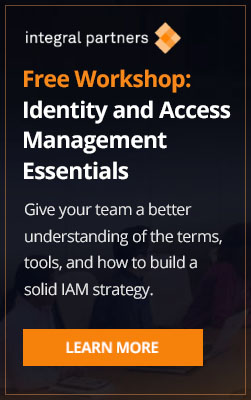Gartner 2018 Identity Summit – New Year, New Acronyms, Same Message
Following the final presentation at this year’s Gartner Identity Summit, over 2,000 identity professionals departed Las Vegas and contemplated three and a half days of analyst insights, vendor hype, practitioner perspective and peer lessons. Based on shared information, the attendee’s task was to distill learnings and prepare 2019 IAM activities while resolving familiar and recurring challenges.
Like many conference goers, Integral Partners left the Gartner summit with curiosity and enthusiasm over repeated promises of identity’s continued acceleration through adoption of artificial intelligence, machine learning, robotic process automation and advanced analytics. Despite the bright future, we remained more convinced than ever foundational identity success continues to be dependent on organizational change, stakeholder engagement, process improvement and technical compatibility.
In the opening keynote, Gartner introduced the concept of ‘Continuous Next’ which is the idea identity is a constantly evolving entity and organizations should prepare to transform identity projects to a ‘product’ to be enhanced through automation, adaptive intelligence and sensitivity to business requirements and regulatory mandates.
Gartner’s ‘Continuous Next’ expands the value proposition of perpetual application integration and workflow automation to a forward-thinking approach of coordinated orchestrations creating service driven identity and leveraging real time and continuous standards-based authentication. The identity ‘product’ is continually refined by analytics to deliver strong security, accelerated system integration and frictionless user experience.
At Integral Partners, we are responsible to deliver tangible value from our client’s identity investments and a majority of people we encountered at Gartner manage identity programs which exist a great distance from Gartner’s ‘Continuous Next’ future. Throughout the conference, we found ourselves reinforcing the need to remain committed to non-technology priorities before being wooed by the automation and analytic promises of ‘Continuous Next’.
Early in the conference we spent time with the security team from of a global medical device company which was struggling with user administration of third-party vendor partners. Searching for a technology approach to improve the process, we asked the simple question; “Who best understands the active employment status of vendor partners and who should do the work to manage non-employees based on their status? Your company or theirs?”. By changing focus from a technology solution to workflow and governance approach, we guided the team to prioritize delegated administration functionality versus more common directory focused third party management solutions.
We met with multiple healthcare leaders whose identity programs currently exist in various stages of automation and are focused primarily on access, attestation and audit for critical, Electronic Medical Records (EMR) systems. Having purchased multiple IGA/PAM/SSO/MFA technologies, they felt 2019 would be right time to revisit overall identity strategy to avoid technology overlap and maximize existing investments.
As identity functionality has evolved with extended technology ecosystems, an effective program strategy update requires re-engaging stakeholders in development, patient portal teams, audit, HR and key line of business influencers. We advised on how to promote simplified experience, establishing consistency in identity/security standards, accelerating adoption on new SaaS solutions and ensuring governance oversight be embedded in planned identity functionality.
Several financial services companies faced struggles to gain recognition for the value identity programs were bringing to their company and ended up with extra work because of lack of funding for ongoing investment. We introduced examples of ways to present identity investment in strategic and incremental building blocks and how to share IAM value in terms of business agility, external user control and revenue generated from consistent and secure user interactions. These justifications could be validated by peers and competitors then tailored to the needs of the organization, not the capabilities of the automation tools.
Finally, we encountered identity professionals from retail, utilities and higher education who simply felt their identity programs were not far enough ahead on fundamentals to take advantage of the future looking approaches Gartner introduced. These companies were continuing to struggle to get IGA, PAM, and AM in place and functioning at a level to demonstrate clear and tangible ROI justification to executives and stakeholders.
For this group of attendees, the most valuable part of the Gartner conference was the ability to share challenges with peers who faced similar situations and could share what worked, what failed, lessons learned and how they were continuing to generate program support and funding (so they could keep attending Gartner). In fact, the peer to peer networking and impromptu conversations is the feedback we consistently heard that made the Gartner Summit relevant and valuable for identity leaders.
In summary, Gartner’s annual identity remains our industry’s most important professional event because forward-thinking analysts are tempered by the hundreds of professionals who balance the promise of tomorrow with the realities of today and share their experiences for practical outcomes.
Integral Partners take away from Gartner 2018: despite new acronyms, new promises, and smarter technology, the identity success message remains the same. You must get your house in order before being wooed by tools and technology because people, process and policy need to be in line before any solution will fully realize its potential. For most identity leaders, 2019 will be more ‘continuous now’, than ‘Continuous Next’.


Comments are closed.